MARIANI’S
Virtual Gourmet
April
28, 2019
NEWSLETTER
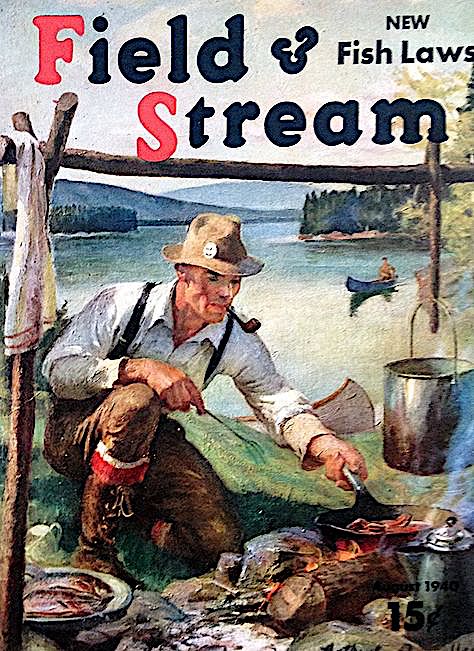
❖❖❖
IN THIS ISSUE
SWITZERLAND
By John Mariani
NEW YORK CORNER
THE WOO
By John Mariani
NOTES FROM THE WINE CELLAR
The Pommards of Domaine de Courcel
By John Mariani
❖❖❖
SWITZERLAND
By John Mariani
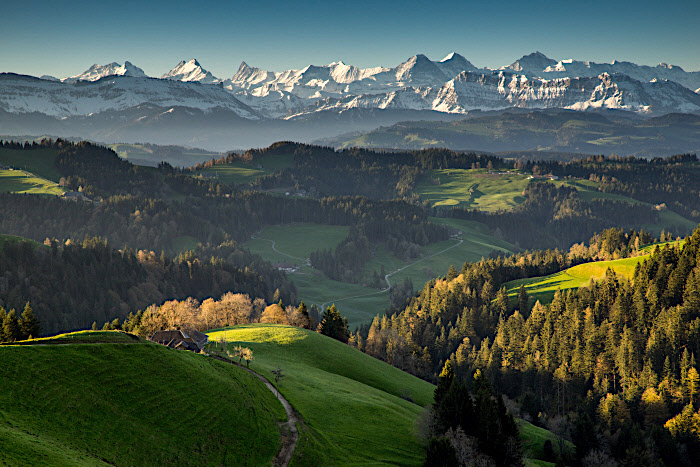
Photo by Jan Geerk
With
just 8.5 million inhabitants and 11
million annual tourists, Switzerland has plenty
of room for everyone, which
means that one never feels anything like the
crush and traffic of Rome, Paris,
Madrid or Athens in Swiss cities.
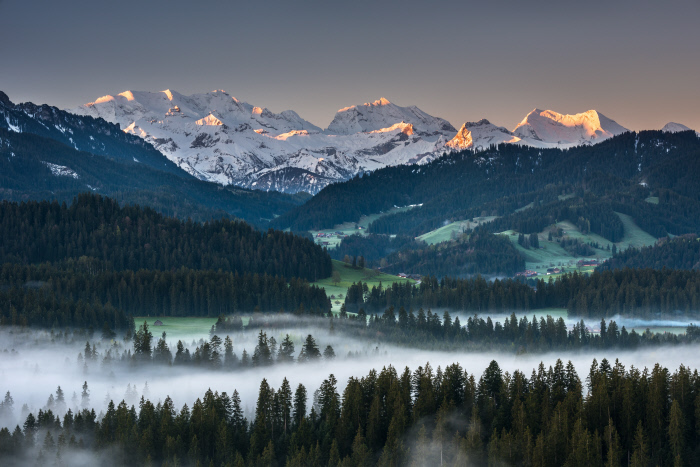 There are
no long, snaking lines to get into
Swiss museums, as there are at the Vatican, the
Louvre, the Prado or the
Pantheon. No need to book restaurants weeks in
advance. And, while all the
international fashion brands have stores in the
big cities, it’s better to seek
out the less expensive, more distinctive Swiss
designer shops on the smaller
streets.
There are
no long, snaking lines to get into
Swiss museums, as there are at the Vatican, the
Louvre, the Prado or the
Pantheon. No need to book restaurants weeks in
advance. And, while all the
international fashion brands have stores in the
big cities, it’s better to seek
out the less expensive, more distinctive Swiss
designer shops on the smaller
streets.
It’s also easy enough to blend
in with the
local citizenry of Zurich, Lucerne, Lausanne,
Vevey, Basel, Lugano and
Geneva. The
ski slopes of St.
Moritz, Zermatt and Gstaad get very busy in
winter, and in spring, summer and
fall the lakes and mountains may be dotted with
hikers, climbers and boaters,
but the number of dots will be small within the
vastness of the territory. Snow-capped
mountains loom over every
lake, and their cloud-reflected blue waters are
clear to remarkable depths. You
might not want to but you could actually drink it.
Wachseldorn
Photo: Martin Maegli
A recent
ten-day trip to Switzerland—nine with
perfect weather—showed both its cities and the
countryside in ideal relief, and
the word “frantic” never entered my mind. My usual
New York stride slowed to a
Swiss stroll, and, since everything runs on time,
I never had to rush
anywhere. No
one would ever make
an idle bet against the on-time performance of a
bus, a tram, a subway or a
train, because they always depart and arrive on
the second. If you have a train
 leaving
Zurich at, say, 9 a.m., and the tram from your
hotel takes exactly four
minutes, you could leave your hotel at 8:50 and
have time to spare to grab a
coffee before getting on the train.
Over those ten days I never once used a
taxi or Uber, because the
transportation system is so efficient everywhere.
leaving
Zurich at, say, 9 a.m., and the tram from your
hotel takes exactly four
minutes, you could leave your hotel at 8:50 and
have time to spare to grab a
coffee before getting on the train.
Over those ten days I never once used a
taxi or Uber, because the
transportation system is so efficient everywhere.
The
best way to travel around the country is to buy a
Swiss Travel Pass, an
all-in-one ticket that gives access to trains,
buses and boats on 3, 4, 8 or 15
consecutive days, plus admission to 500 museums
(out of 1,000). With the Swiss
Travel Pass Youth, people under 26 years of age
benefit from a 15 % discount
off the regular fare. (For info and prices go to:
swiss-travel-pass).
Glacier Express
Photo: Andrea Badrutt
The
problem with clichés is that they become
outdated and fatuous, like calling Paris the City
of Lights, Las Vegas Sin City
or New York the Big Apple. But so many of the
clichés about Switzerland remain
delightfully true, not least that on-time
performance. Indeed, there’s a very
funny book entitled How to Be
Swiss
by Diccon Bewes and cartoonist Michael Meister
that sends up enduring Swiss
habits that include “Thou shalt eat chocolate
daily”; “Kiss strangers three
times on the cheek”; “Address your boss as
‛Mister’ until one of you dies”;
“Feel lost when you travel an hour across country
and can’t understand anyone”;
and “Feel superior.” (More on this last later.)
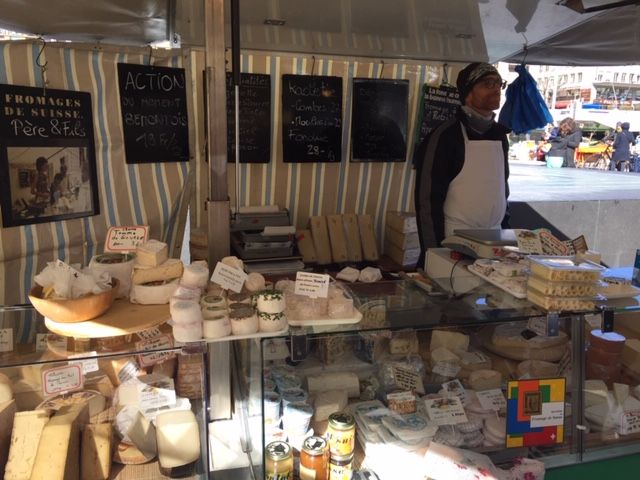
The German, French and Italian
cantons are,
certainly, very protective of their respective
cultures, but all pride
themselves on being open to new ideas via polite
social democracy. To bring an
idea to a vote, one need only gather 200,000
signatures, as one fellow did when
he tried to pass a law that would prohibit the
cutting of goats’ horns, a
traditional process that keeps them from injury
and saves space; the measure
failed.
Cheese
market vendor in Lausanne
Photo: Galina Dargery
I
will happily add that Swiss
cheeses—Emmenthaler, Gruyère, Berner Alpkäse,
L’Etivaz, Schabziger, Raclette,
Sbrinz, Tête de Moine, and many others—and breads
are among the best in the
world. First-rate Swiss wines are wholly
underappreciated because no more than
two percent of the production ever leaves the
country. Swiss restaurants, from
casual eateries serving raclette and fondue to
haute cuisine dining salons, are
excellent.
As for the Swiss air of
superiority, I believe
it is more true about the 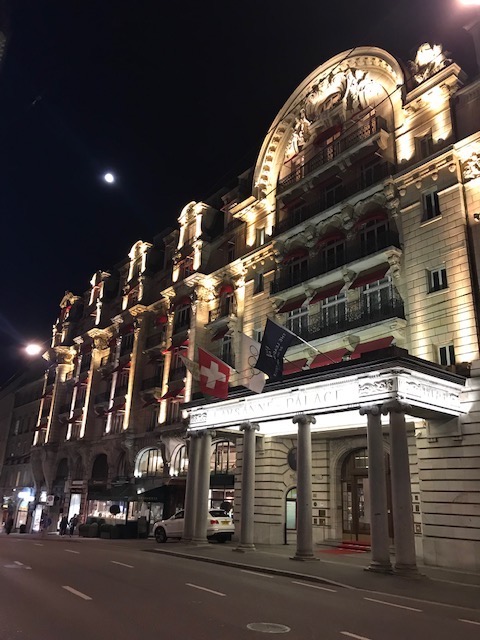 last generation than the
current one. I recall some
fifteen years ago my wife, who speaks fluent
French, endured a dinner table
conversation among middle-aged
locals, in Swiss French, who gloated about how
unsophisticated Americans were.
At meal’s end, my wife stood up, smiled and said,
in perfect Parisian French,
“We are leaving now and hope never to meet any of
you pompous snobs ever again.”
last generation than the
current one. I recall some
fifteen years ago my wife, who speaks fluent
French, endured a dinner table
conversation among middle-aged
locals, in Swiss French, who gloated about how
unsophisticated Americans were.
At meal’s end, my wife stood up, smiled and said,
in perfect Parisian French,
“We are leaving now and hope never to meet any of
you pompous snobs ever again.”
But on more recent trips I
found the Swiss
wonderfully cordial and eager to help in any way
they can. And the fact that
just about everyone, at least in the cities, under
the age of forty now speaks
English makes an American tourist feel very
comfortable at every turn. And the
streets are astoundingly clean.
It is certainly true that
Switzerland is an
expensive place to live and visit.
Eurostat ranks Switzerland’s consumer
prices as the most expensive in
Europe overall and 61% higher than the EU average,
with food and non-alcoholic
drinks 73% higher, hotels and restaurants 67% and
clothing 43%. I certainly
found prices in the cities I visited high, though
they won’t come as much of a
shock to anyone who visits London, Paris, Berlin,
Moscow, New York or San
Francisco. Still, many Swiss cross over to France
to go shopping to save money.
Lausanne Palace
Photo:
Galina Dargery
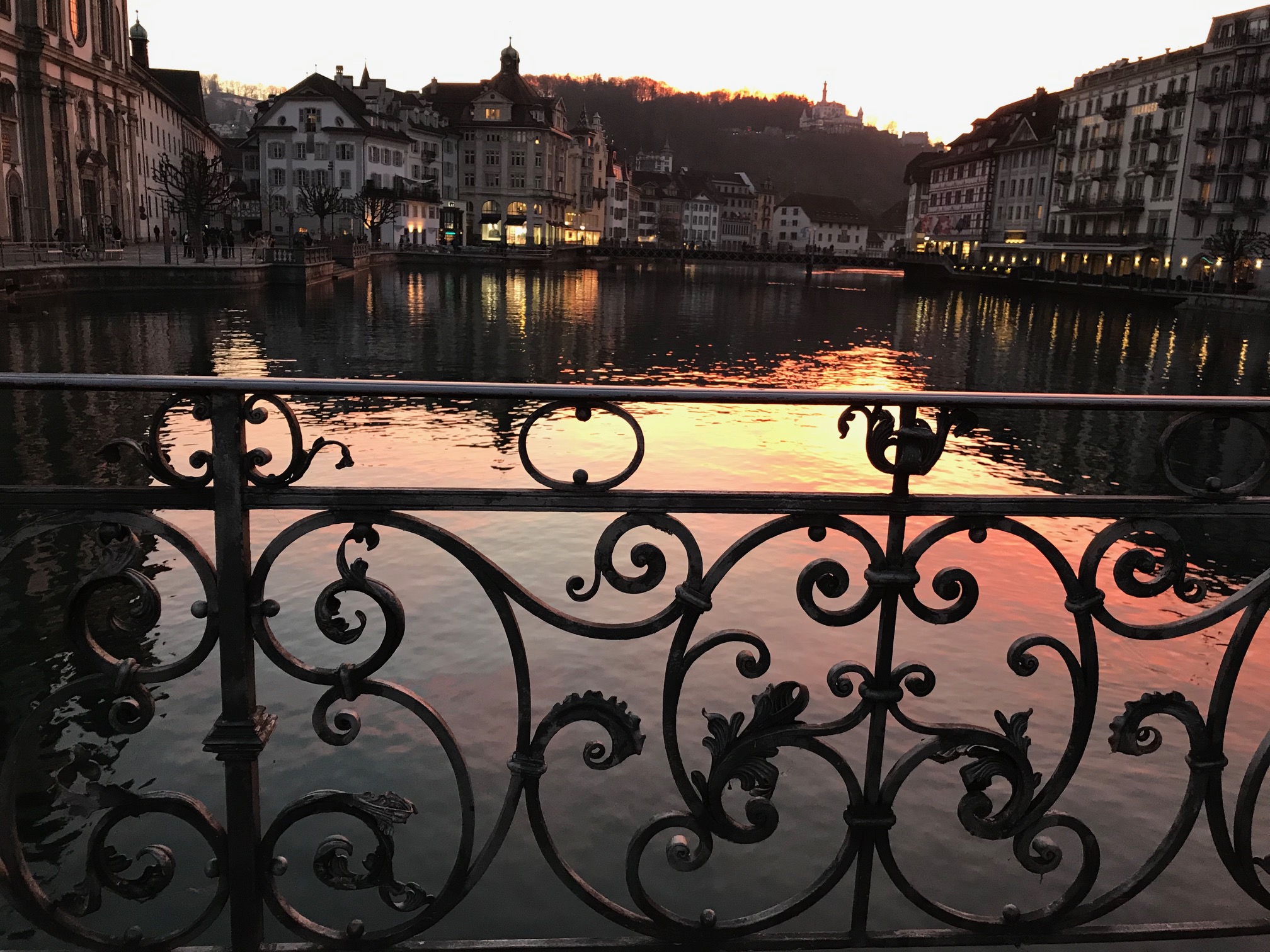 We found there were
plenty of
hotels—this was in early spring—under $150 a night
(the US dollar is now just
about at parity with the Swiss franc, which makes
calculating easy), and the
most deluxe restaurants, while pricey, cost
somewhat less than comparable restaurants in
Paris or London. And always
remember: A 35 franc main course in Switzerland
includes VAT and service
charges, whereas in the U.S. a comparable main
course might cost $28, but with
tax and tip comes out to about the same. (Tipping
is not expected in
Switzerland.)
We found there were
plenty of
hotels—this was in early spring—under $150 a night
(the US dollar is now just
about at parity with the Swiss franc, which makes
calculating easy), and the
most deluxe restaurants, while pricey, cost
somewhat less than comparable restaurants in
Paris or London. And always
remember: A 35 franc main course in Switzerland
includes VAT and service
charges, whereas in the U.S. a comparable main
course might cost $28, but with
tax and tip comes out to about the same. (Tipping
is not expected in
Switzerland.)
Lucerne at
twilight
Photo: Galina Dargery
I
shall be writing a series of articles about
the individual cities I visited on
my trip, but let me mention one more thing about
Switzerland: Nowhere—not on
the street, in the train station and airport, on
the metro, in restaurants of
any stripe—was there anything like the cacophony
of noise one experiences in
similar places in American cities. A full dining
room in Switzerland will have
a happy ebullience about it, but no one is
screaming to be heard—unless it is
packed with foreign visitors. Perhaps to be Swiss
means never to guffaw.
❖❖❖
By John Mariani
THE WOO
206 Spring Street (near 6th Avenue)
212-925-2364
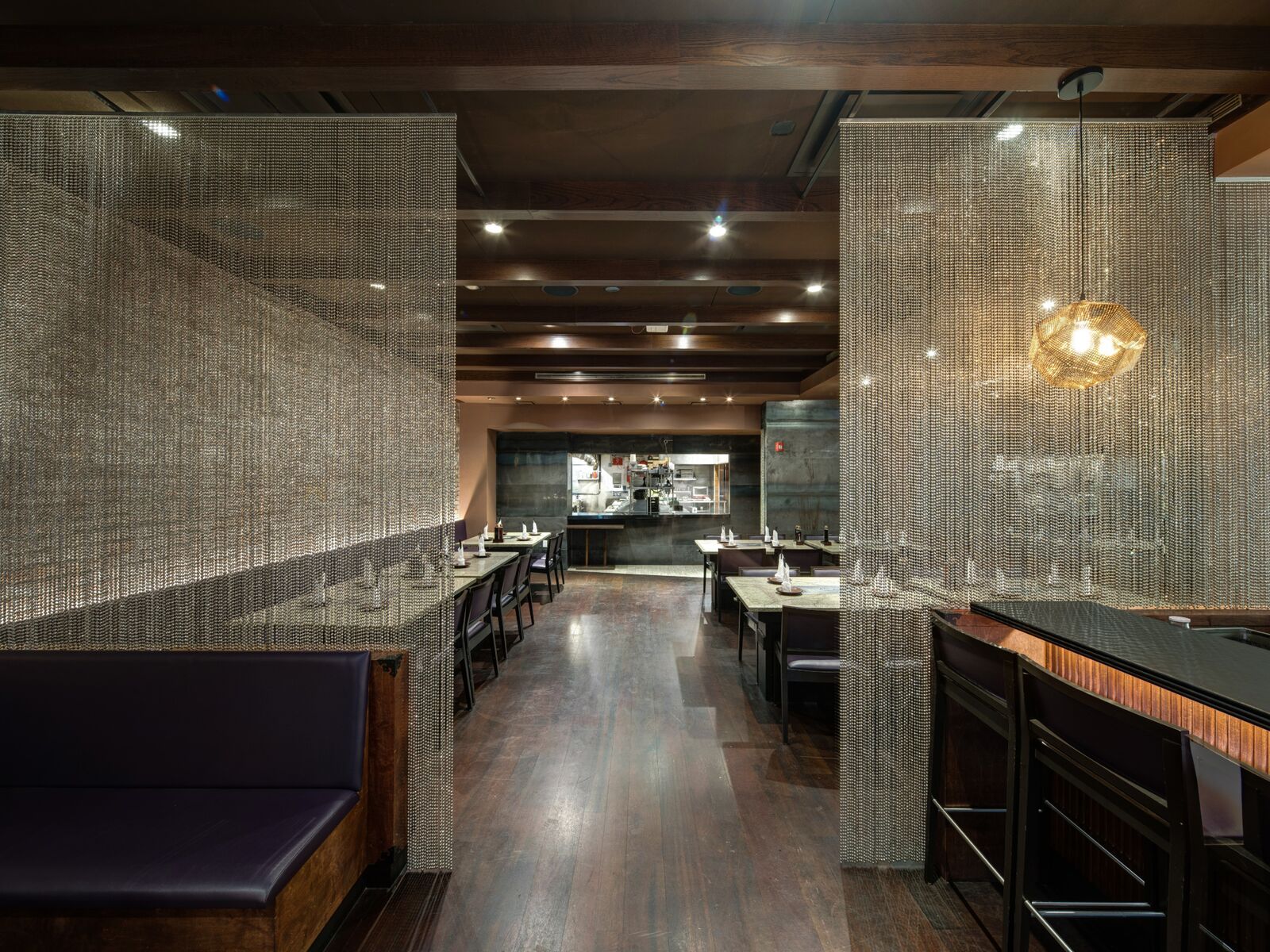
It’s
almost become a requisite for the New York
food media to ignore all Asian restaurants
with any high degree of design,
preferring instead cramped spots in the outer
boroughs with ten stools, raucous
atmosphere and no wine list. This is certainly
true of the swath of Korean
restaurants currently trending, but I’m hoping
the sleek, shadowy good looks of
The Woo will afford readers a far more
comfortable and exciting evening out.
Owner Julie Choi’s
pedigree goes through three
generations, dating to 1974, when her
grandmother, Chung Bong
Lee, opened Woo Lae Oak in
Midtown, when a Korean restaurant of
any kind was a rarity. In 1999, Choi’s
mother, Young Sook Choi, opened another
location in Soho. Julie herself
holds
a Grand Diplôme of Cuisine and Pastry
Arts from Le Cordon Bleu
Culinary School in London and
an International Hospitality
Management degree from École
Hotelière de Lausanne in
Switzerland.
Chef de cuisine Eli
Martinez has worked
for the Choi family for all those years and is
thoroughly imbued with their
passion for fine Korean food and service.
The dramatic two-level space
(which used to be
Fiamma, then Costata) is a very modern update on
the original Woo Lae Oak, with
a sweeping downstairs bar area and open kitchen.
Upstairs the long dining room
has polished ceiling beams, a row of
granite-topped and smokeless barbecue
tables set against violet booths on distressed
wooden 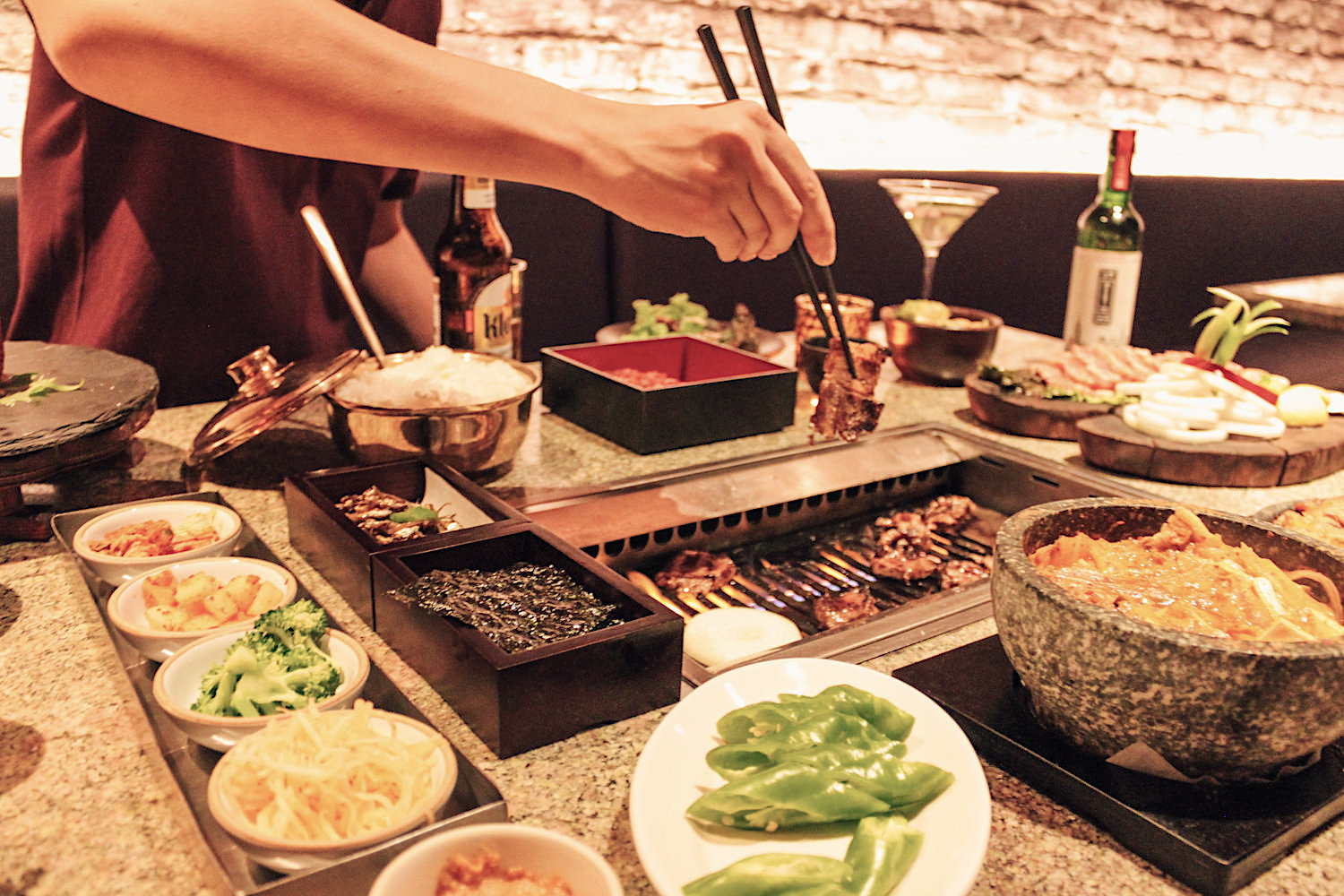 floors, all brightened
by
star-like ceiling lights. There’s some
background music, but it’s not enough to
be intrusive.
floors, all brightened
by
star-like ceiling lights. There’s some
background music, but it’s not enough to
be intrusive.
The menu is very, very long,
and since the
barbecue is the showpiece, you need to be
careful how much else you order
around it.
Four of us made a dent
into several categories but missed some others.
I’ve rarely had a dumpling I
didn’t like, and
my streak continued on a high level with the mandu pan-fried dumplings (above)
stuffed with beef short rib served with a
chili and soy sauce ($15). Yook
hwe ($17)
is a well-cut, well-seasoned version of
soy-marinated steak tartare with quail
egg and Asian pear, which has savory
salty-spicy-citrus-sweet flavors that play
off the raw beef. Looking like Greek dolmas,
ke sal
mari ($17) are wraps of
spinach crêpes containing crab and leek with
Korean mustard sauce, and ga ri bi
gui ($17) is a highly
delectable mélange of scallops, shrimp and
Korean pine nuts baked and lavished
with a light seafood mousse.
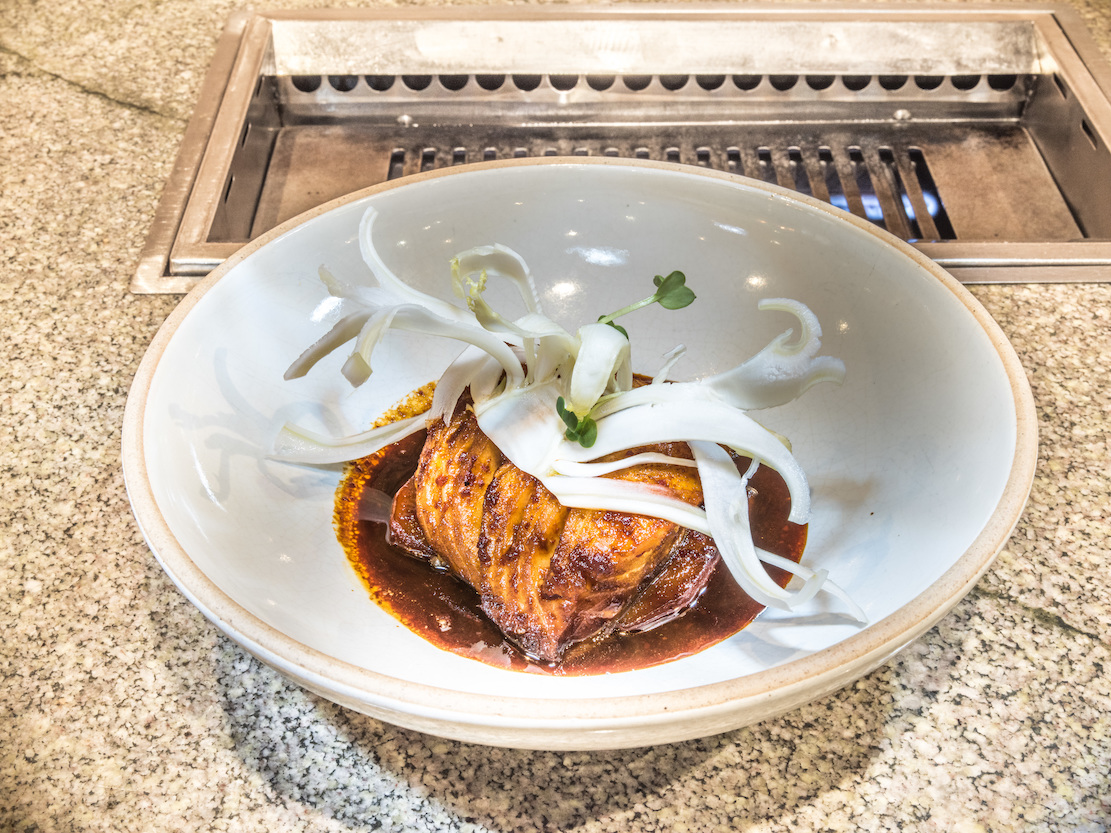 Classic
Korean bi bim bap, which means “mixed
rice,” is an artful
presentation of rice, assorted
marinated and fresh vegetables simmering in a
hot stone pot and topped with a
fried egg ($24). Un dae gu
jo
rim ($34) shows a real hand at
lustrous seafood by simmering rich
black cod and daikon in a deeply reduced sweet
and spicy garlic soy broth.
Classic
Korean bi bim bap, which means “mixed
rice,” is an artful
presentation of rice, assorted
marinated and fresh vegetables simmering in a
hot stone pot and topped with a
fried egg ($24). Un dae gu
jo
rim ($34) shows a real hand at
lustrous seafood by simmering rich
black cod and daikon in a deeply reduced sweet
and spicy garlic soy broth.
There are several options for
self-cooked
barbecue, and I must say the smokeless burner
used at The Woo really works as
it’s supposed to, keeping fumes as well as
grease away from your face and
clothes. The most popular variety is kal
bi, made with remarkably well-marbled beef
short rib ($38); Bulgogi ($36)
is a nearly as rich
ribeye in slices; Hyaw
mit ($30)
is thinly sliced beef tongue; O ree ($32)
is Long Island duck breast; and
there are two seafood 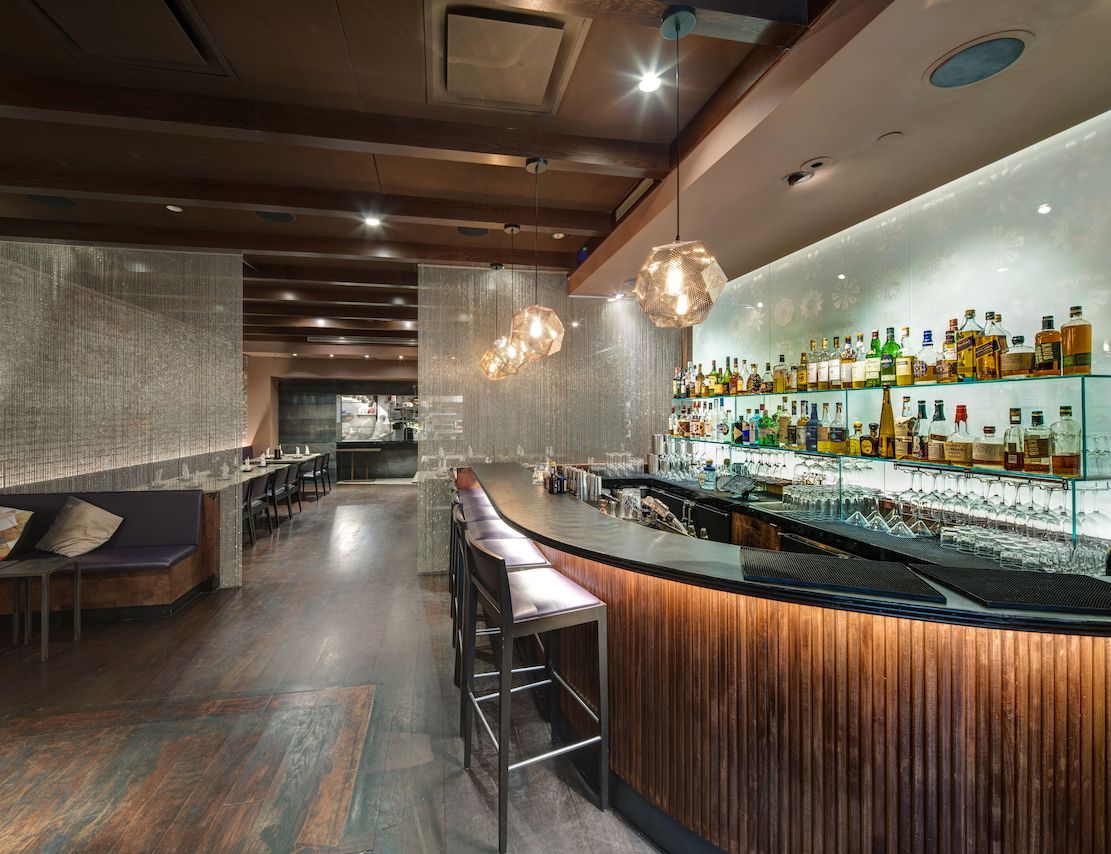 options—hwang sae
chi ($34) of swordfish and cham
chi of yellowfin tuna loin ($28). You
slip the main ingredient on the
grill, then put together your wrap of lettuce
with an array of delightful
condiments of heat, spice and various textures.
options—hwang sae
chi ($34) of swordfish and cham
chi of yellowfin tuna loin ($28). You
slip the main ingredient on the
grill, then put together your wrap of lettuce
with an array of delightful
condiments of heat, spice and various textures.
We weren’t quite done yet—the
food here is
actually fairly light—so we had a hotpot called
ben jang chige ($18), rife with
pork, zucchini, chili, mushrooms
and sweet onions, a dish that was very soothing
at that point in the meal.
Desserts are pleasant enough,
including
Tropical Snow, shaved coconut ice with sweet
jellied fruits, sweet beans,
coconut ice cream and raspberry and vanilla
sauces.
Julie
is ever present to make recommendations
and to show you the correct way of eating this
wonderful food. Her personality
is a big part of the charm, and her taste in
décor raises Korean restaurants to
a new level in New York.
Open
for lunch and dinner daily.
Domaine de Courcel
By John Mariani
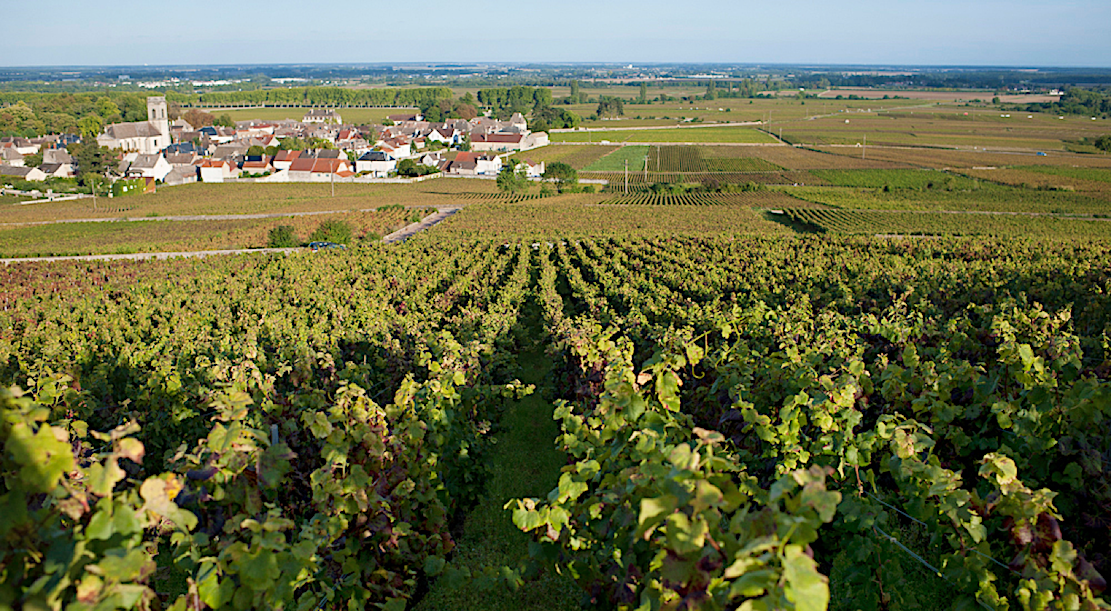
Every
varietal has its own distinctive smell—the smoky
brick of Bordeaux, the
tropical fruit of Sauvignon Blanc, the spiciness
of Gewürztraminer—but the
aroma of good Burgundy is one of Pinot Noir’s
great pleasures, one not often
found in examples from California or Australia.
To be more romantic, Burgundy’s
“bouquet” does open up like buds in bloom, and
it is richly satisfying, even
before you taste the wine.
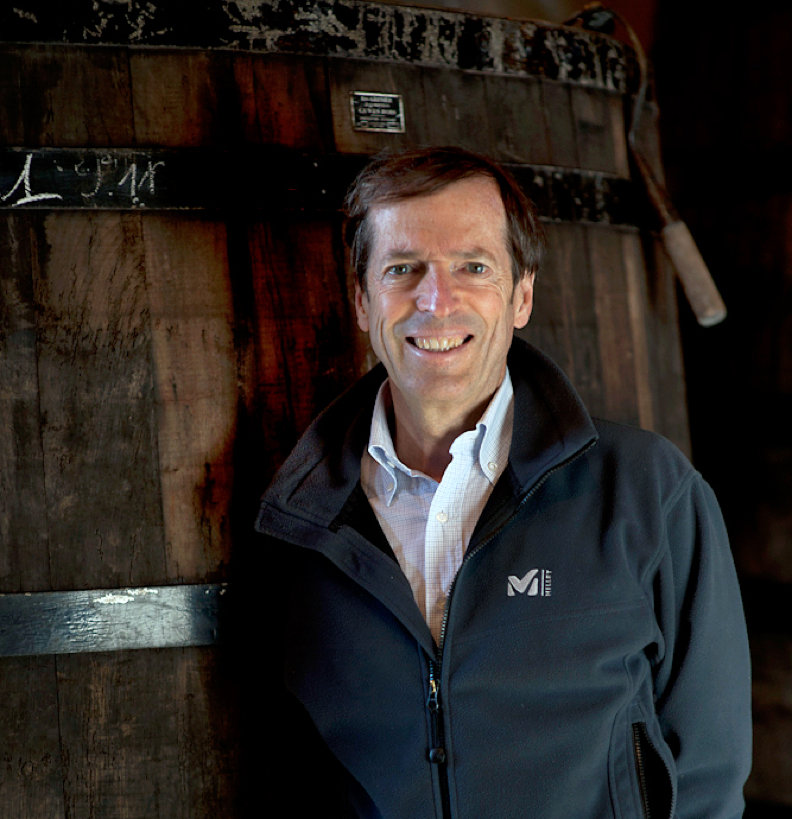 I
was reminded of this while tasting eight examples
of Pommard from Domaine de
Courcel with owner Gilles de Courcel (left) over
dinner in New York. He is a wiry
fellow who looks as if he’s happiest in the
vineyards, checking the grapes’
ripeness, watching the rain clouds and shading his
eyes from the Burgundian
sun, although he actually lives in Bordeaux. His
family has been at the estate
for four centuries, and he took over its
management in 1983 together with his
sisters, Anne Bommelaer and Marie de Courcel.
I
was reminded of this while tasting eight examples
of Pommard from Domaine de
Courcel with owner Gilles de Courcel (left) over
dinner in New York. He is a wiry
fellow who looks as if he’s happiest in the
vineyards, checking the grapes’
ripeness, watching the rain clouds and shading his
eyes from the Burgundian
sun, although he actually lives in Bordeaux. His
family has been at the estate
for four centuries, and he took over its
management in 1983 together with his
sisters, Anne Bommelaer and Marie de Courcel.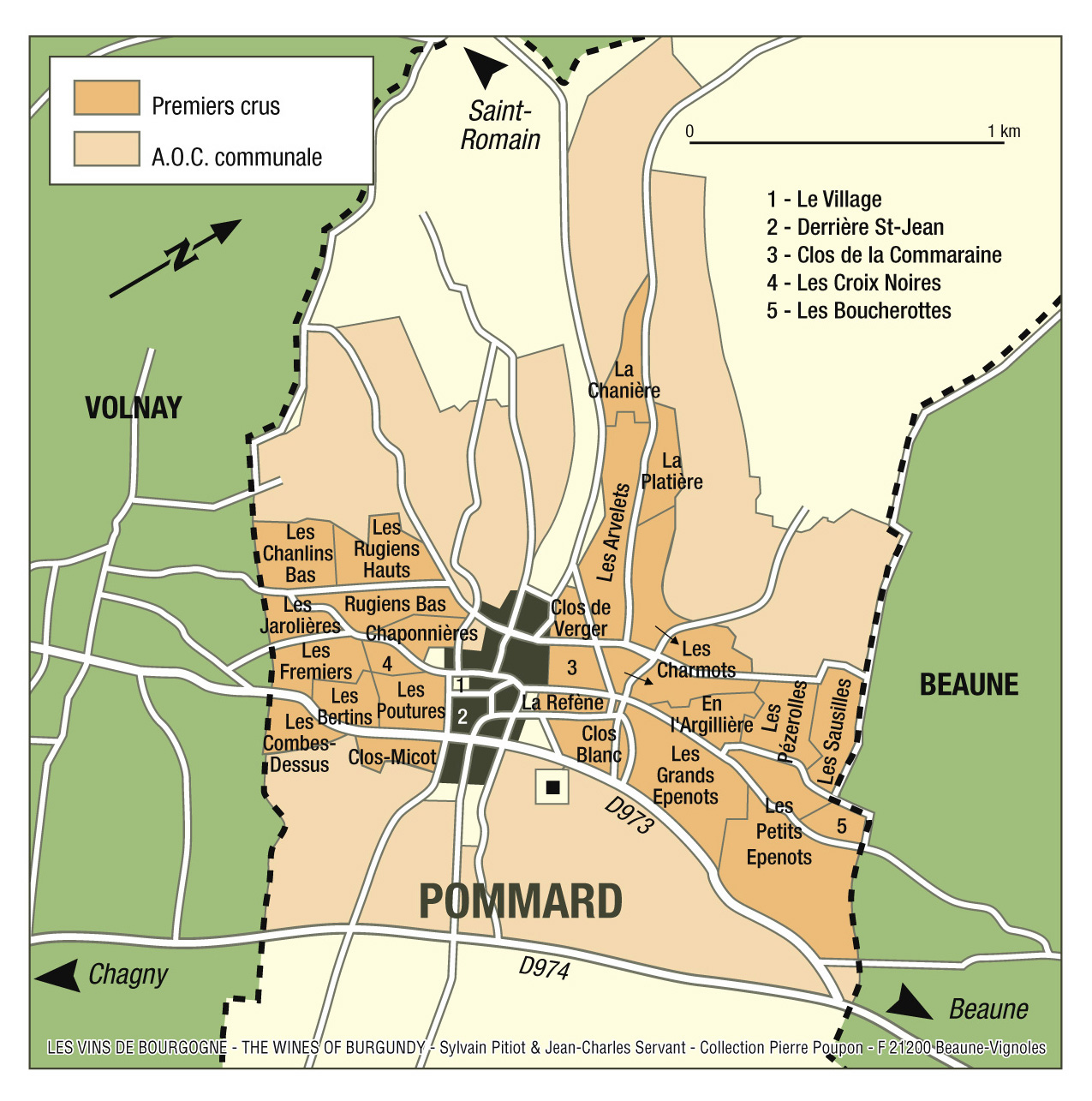
The
domaine, arrayed over 26 acres, has always sold
its own wines, rather than sell
them to a negoçiant, which is more common in
Burgundy. (About 95% of the
Pommard vineyards are owned by families, and 50%
sell their own wines.) The
vineyard area of the Pommard region (Pommard
itself is a village) is one of the
largest within Burgundy—about 850 acres—with the
best estates under the
appellation Premier Cru, and within that
illustrious group, Épenots and Rugiens
are the most highly rated. Lesser Pommards are
produced in very large
quantities; Domaine de Courcel’s production is
never more than 30,000 bottles
per year.
De
Courcel is most certainly committed to both the
traditions of his family and
the estate’s terroir, improving the estate itself
as well as the vineyards, and
says that “Too often winemakers make a style, not
a wine,” which is what many
negoçiants do when they blend wines they buy from
different estates.
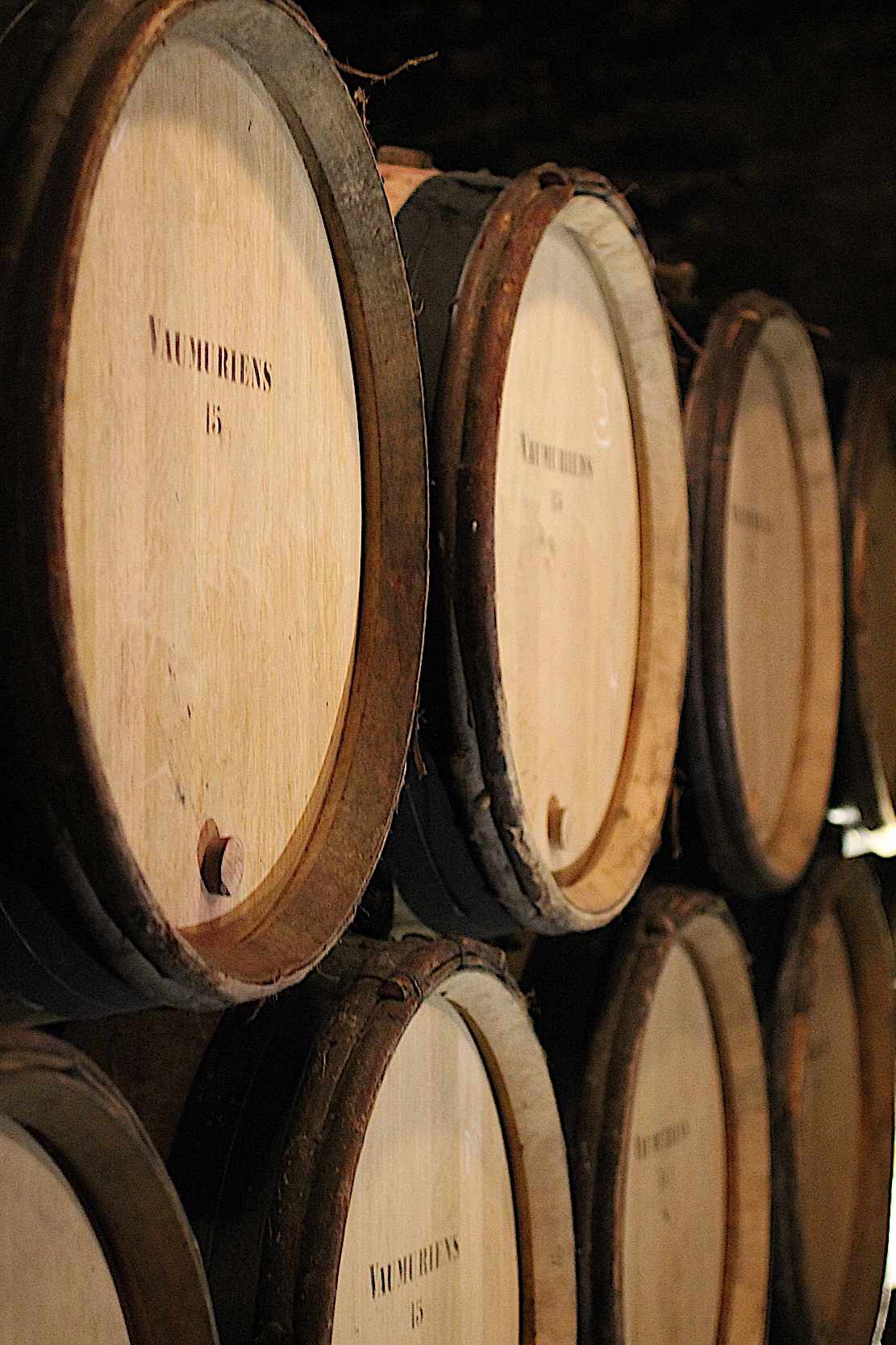 In addition to
its Grand Crus, the
domaine produces another Pommard called Les
Vaumuriens. Over our dinner of roast chicken, frites and sweetbreads at Benoit
bistro in Manhattan, the 2016 vintage
($120) was aromatic and lustrous, from a high
terroir with a large percentage
of limestone.
In addition to
its Grand Crus, the
domaine produces another Pommard called Les
Vaumuriens. Over our dinner of roast chicken, frites and sweetbreads at Benoit
bistro in Manhattan, the 2016 vintage
($120) was aromatic and lustrous, from a high
terroir with a large percentage
of limestone.
The
Grand Clos des Épenots accounts for 50% of the
domaine's production, and while
Pommard has a reputation for being heftier than
other Burgundies, Épenots are a
somewhat softer expression of Pommard and
constitute the largest acreage of the
domaine. The 2016 ($176) has Pommard’s typically
deep color, layers of silky
fruit and a long finish, while the 2015 ($166) was a
bigger wine, a bit more tannic and will take a
few years to mature.
I was fortunate to taste
two older examples of Épenots—the 2006
($186), which was lighter in color and in
impeccable balance (“The years have
been very kind to the 2006,” said de Courcel),
while the 1999 ($286), from a
very large crop, had a bit of a barnyard smell one
associates with older
Burgundies, but a few moments in the glass brought
all its elements
of fruit
and acid into supple equilibrium. It showed the
lasting power a Pommard can
exhibit twenty years after being made.
There was also one Les Rugiens
to taste, a 2015 ($223), which, despite its
youth, was delicious.
Rugiens (the name derives from the red soil) is a
bigger wine than Épenots, yet
it had none of that overpowering plumminess you
find in hot California Pinot
Noirs. It went extremely well with a course of
three French cheeses.
Since
I faced a 40-minute drive home it
killed me not to be able to drink every drop
poured and to have to drain out
the remains to make way for the next wine. For one
thing—and at these prices—I
rarely get a chance to drink Pommard. Perhaps next
time Gilles de Courcel
invites me for dinner in New York, I’ll get a
hotel room for the night and have
sweet dreams about all the wonderful wines I drank
every drop of.
 FOOD WRITING 101: BLOCK
THAT METAPHOR!
FOOD WRITING 101: BLOCK
THAT METAPHOR!
"It’s a little bit as if Barbra
Streisand had returned
to Broadway, and then sang all her songs in a whisper
sitting on the edge of
the stage. It might not be what you had been waiting
for, but you’d watch."—Pete
Wells, "The Standard Grill," NY Times (April 2, 2019)
AND
FRITES MADE
WITH SOYBEANS CANNOT BE CALLED "FRITES"
An amendment proposed to the European Union’s
agricultural committee would make it so that veggie
burgers could not be called "burgers." French
member of parliament Éric Andrieu told the Guardian
that words like “steak” ought to “be kept for
real
steak with meat.”
Wine
Column Sponsored by Banfi Vintners
SANGIOVESE
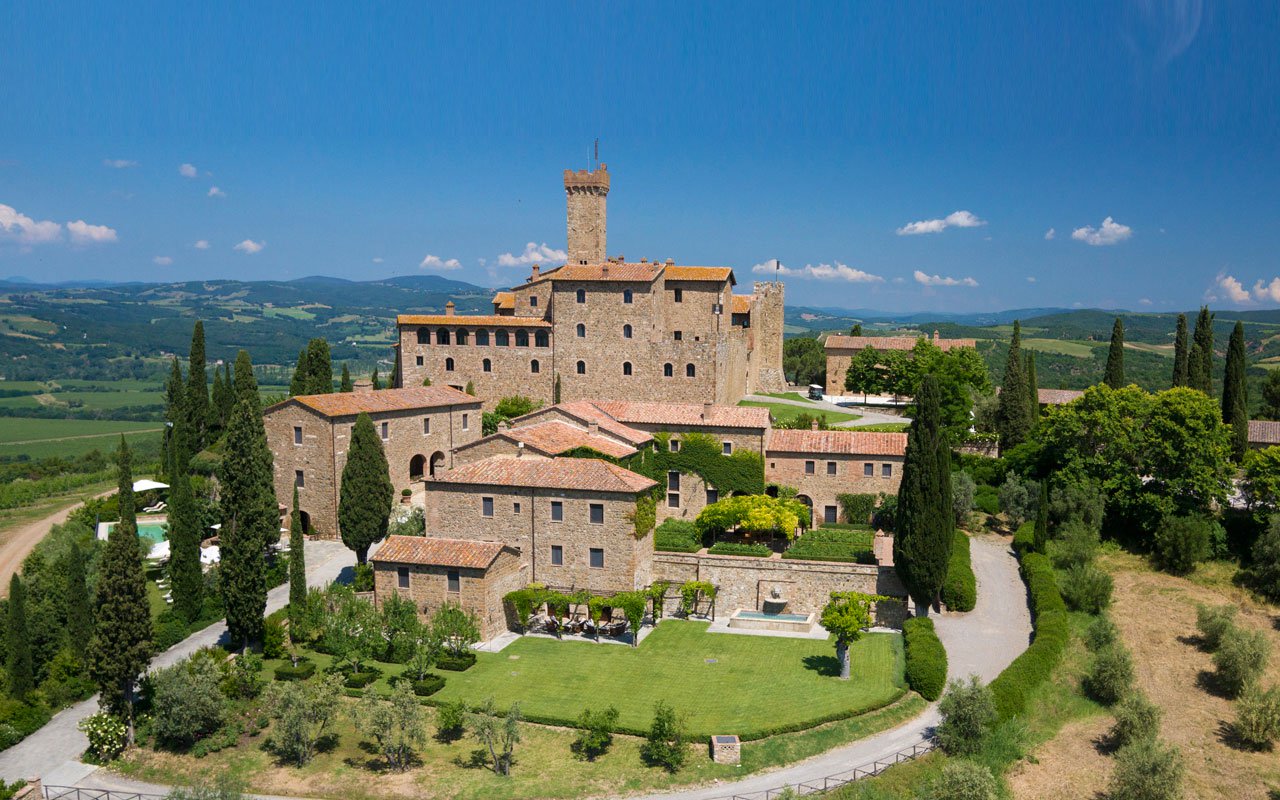 Wine is a joy year-round but
in cooler weather one
grape varietal has really taken center stage in
my daily activities – that most Italian of
grapes, Sangiovese, and its ultimate expression
– Brunello di Montalcino.
Wine is a joy year-round but
in cooler weather one
grape varietal has really taken center stage in
my daily activities – that most Italian of
grapes, Sangiovese, and its ultimate expression
– Brunello di Montalcino.
From mid-September through mid-October,
the Sangiovese grown for our various styles of red
wines are be harvested, culminating with the top
selection for Brunello di Montalcino.
Second, cooler weather here means
it is time to start enjoying more red wines and
especially Sangiovese based wines. That
includes Banfi’s cru of Brunello, Poggio alle Mura,
literally the cream of the crop of our Sangiovese
vineyards. Alongside our Poggio alle Mura Brunello di
Montalcino, this year we introduced two more wines
from the cru Poggio alle Mura – a Rosso di Montalcino
and a Riserva of Brunello. Rosso is sort of like the
younger brother of Brunello, also made from 100%
Sangiovese grapes but usually a selection from younger
vines and the wine is aged only two years compared to
the four required for Brunello. The
Riserva, on the other hand, is an even more selective
harvest of Sangiovese, and ages for an additional year
before release.
What is so special about this cru
Poggio alle Mura?
Well, it is the result our over 30 years of
ongoing research at my family’s vineyard estate,
Castello Banfi.
When we first began planting our vines there in
the late 1970s studies from the University of Bordeaux
indicated which strains of many varietals we should
plant, based on the soil type and microclimate of each
vineyard. But
when it came to the region’s native Sangiovese, there
was only local lore, no scientific research. So we took
it upon ourselves to figure out this vine, and set off
on three decades of incredibly detailed research.
We started
with 600 apparent variations on Sangiovese, because it
is so susceptible to variations in weather and soil,
and narrowed that down to 160 truly genetically
different clones.
We planted a vineyard with two rows of each
type, made wine from each of them, and charted the
differences – remember, you only get one chance a year
to make wine, so this took time.
It took about ten years to get some
concrete results, though we continue to experiment
today and always will – you never stop learning in
science and nature!
Once we determined which were the best,
complementary clones that could be planted together to
make the best Brunello, we chose to plant them in what
we determined to be the optimal vineyard sites. Coincidentally,
the best soils and climate conditions are in the
slopes surrounding the medieval fortress today known
as Castello Banfi, known since Etruscan times as
Poggio alle Mura – the walled hilltop. Hence the
name of our most special “cru” of Brunello,
representing a synthesis between tradition and
innovation.
Though the focus of this study was
our Brunello, all of our Sangiovese-based wines,
including the super Tuscans SummuS, Cum Laude, and
Centine, benefitted from this work. And that’s
the third reason for celebrating Sangiovese this
month, for the range of wonderful reds that usher us
into autumn! One
wine in particular was inspired by our research – the
BelnerO, a Sangiovese dominant blend with what I like
to call a kiss of Cabernet and a whisper of Merlot. We grow the
grapes a little differently for BelnerO than for
Brunello, make the wine with less oak aging and
released it earlier from the winery, providing a
counterpoint to Brunello and a lovely terroir-driven
wine in its own right.
If you
know Italians, you know that by nature we are
multi-faceted, varying in mood, and always passionate. As a
nation, we span from the hot sunny beaches of Sicily
near the African coast to the rugged mountains and
Alpine ski slopes of Trentino-Alto Adige in the north. Sangiovese
is grown in almost all of Italy’s regions and reflects
the unique nature of each; it is most famous
(rightfully so) in Tuscany, yet even there it reflects
the nuances of each hilltop, valley and subzone. It has
something a little different to say in Brunello than
Chianti, Morellino than Vino Nobile di Montepulciano,
Rosso di Montalcino than Super Tuscan blends.
Here is a smattering of
Sangiovese-based wines that you may wish to get to
know better, reflecting a spectrum that appeals to
every occasion, every taste, and every budget. We can
assure you that the conversation will never become
boring. 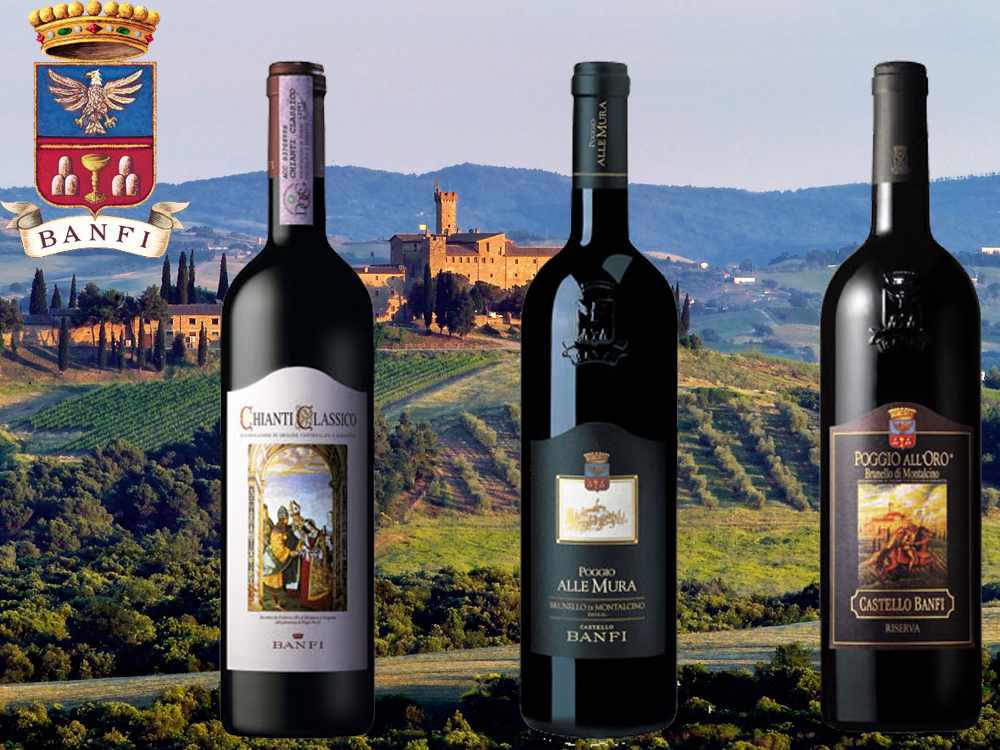
Recommendations for Celebrating
Sangiovese
BelnerO Proprietor’s Reserve Sangiovese
– A refined
cuvée of noble red grapes perfected by our pioneering
clonal research. This dark beauty, BelnerO, is
produced at our innovative winery, chosen 11
consecutive years as Italy’s Premier Vineyard Estate.
Fermented in our patented temperature controlled
French oak and aged approximately 2 additional years.
Unfiltered, and Nitrogen bottled to minimize sulfites.
Castello Banfi Brunello di Montalcino –
Rich, round, velvety and intensely
aromatic, with flavor hints of licorice, cherry, and
spices. Brunello di Montalcino possesses an intense
ruby-red color, and a depth, complexity and opulence
that is softened by an elegant, lingering aftertaste.
Unfiltered after 1998 vintage.
Castello Banfi Rosso di Montalcino – Brunello's "younger brother," produced
from select Sangiovese grapes and aged in barrique for
10 to 12 months. Deep ruby-red, elegant, vibrant,
well-balanced and stylish with a dry velvety
finish.
Poggio all’Oro Brunello di Montalcino
Riserva – A single vineyard selection of our most
historically outstanding Sangiovese, aged five years
before release, the additional year more than that
required of Brunello including 6 months in barrel and
6 months more in bottle to grant its “Riserva”
designation. Incredible
elegance and harmony. Intense with lots of fruit and
subtle wood influence. Round, complete, well balanced
with hints of chocolate and berries. Unfiltered after
1998.
Poggio alle Mura – The first tangible result of years of
intensive clonal research on Montalcino’s native
Sangiovese grape.
Estate bottled from the splendidly sun drenched
vineyards surrounding the medieval Castello from which
it takes its name.
The Brunello
di Montalcino is seductive, silky and smoky. Deep ruby
in color with an expressive bouquet of violets, fruits
and berries as well as cigar box, cedar and exotic
spices. The Rosso
di Montalcino is also intense ruby red. The bouquet
is fresh and fruity with typical varietal notes of
cherry and blackberry, enriched by more complex hints
of licorice, tobacco and hazelnut. It is full
bodied, yet with a soft structure, and a surprisingly
long finish. The Poggio alle Mura Brunello di Montalcino
Riserva is deep ruby red with garnet
reflections and a rich, ample bouquet that hints of
prune jam, coffee, cacao and a light balsamic note. It is full
and powerful, with ripe and gentle tannins that make
it velvety and harmonious; this wine is supported by a
pleasing minerality that to me speaks soundly of that
special hillside in southern Montalcino.
SummuS – A wine of towering elegance, SummuS is an
extraordinary blend of Sangiovese which contributes
body; Cabernet Sauvignon for fruit and structure; and
Syrah for elegance, character and a fruity bouquet. An elegant,
complex and harmonious red wine.
Cum Laude – A complex and elegant red which graduated
“With Honors,” characterized by aromas of juicy
berries and fresh spices.
Centine – A Cuvee that is more than half
Sangiovese, the balanced consisting of equal parts of
Cabernet Sauvignon and Merlot. Vinified in
a firm, round style that easily accompanies a wide
range of dishes, this is a smooth and fragrantly
satisfying wine with international character, and a
perennial favorite at my own dinner table.
Banfi Chianti Superiore – The “Superiore” designation signifies
stricter government regulations regarding production
and aging requirements, as compared to regular
Chianti. An
intense ruby red wine with fruit forward aromas and
floral notes. This
is a round wine with well-balanced acidity and fruit.
Banfi Chianti Classico – An enduring classic: alluring
bouquet of black fruit and violets; rich flavors of
cherry and leather; supple tannins and good acidity
for dining.
Banfi Chianti Classico Riserva – Produced from select grapes grown in the
"Classico" region of Chianti, this dry, fruity and
well-balanced red has a full bouquet reminiscent of
violets.
Fonte alla Selva Chianti Classico – This is our newest entry into the Chianti
arena, coming from a 99 acre estate in Castellina, the
heart of the Chianti Classico region. The wine is
a captivating mauve red that smells of cherry, plum
and blackberry with hints of spice. It is
round, full and balanced with very good
acidity.
Col di Sasso – Sangiovese and Cabernet Sauvignon. Luscious,
complex and soft with persistent notes of fruit and
great Italian style structure.
Any of John Mariani's books below may be ordered from amazon.com.
 The Hound in Heaven
(21st Century Lion Books) is a novella, and
for anyone who loves dogs, Christmas, romance,
inspiration, even the supernatural, I hope you'll find
this to be a treasured favorite. The story
concerns how, after a New England teacher, his wife and
their two daughters adopt a stray puppy found in their
barn in northern Maine, their lives seem full of promise.
But when tragedy strikes, their wonderful dog Lazarus and
the spirit of Christmas are the only things that may bring
his master back from the edge of despair.
The Hound in Heaven
(21st Century Lion Books) is a novella, and
for anyone who loves dogs, Christmas, romance,
inspiration, even the supernatural, I hope you'll find
this to be a treasured favorite. The story
concerns how, after a New England teacher, his wife and
their two daughters adopt a stray puppy found in their
barn in northern Maine, their lives seem full of promise.
But when tragedy strikes, their wonderful dog Lazarus and
the spirit of Christmas are the only things that may bring
his master back from the edge of despair. WATCH THE VIDEO!
“What a huge surprise turn this story took! I was completely stunned! I truly enjoyed this book and its message.” – Actress Ali MacGraw
“He had me at Page One. The amount of heart, human insight, soul searching, and deft literary strength that John Mariani pours into this airtight novella is vertigo-inducing. Perhaps ‘wow’ would be the best comment.” – James Dalessandro, author of Bohemian Heart and 1906.
“John Mariani’s Hound in Heaven starts with a well-painted portrayal of an American family, along with the requisite dog. A surprise event flips the action of the novel and captures us for a voyage leading to a hopeful and heart-warming message. A page turning, one sitting read, it’s the perfect antidote for the winter and promotion of holiday celebration.” – Ann Pearlman, author of The Christmas Cookie Club and A Gift for my Sister.
“John Mariani’s concise, achingly beautiful novella pulls a literary rabbit out of a hat – a mash-up of the cosmic and the intimate, the tragic and the heart-warming – a Christmas tale for all ages, and all faiths. Read it to your children, read it to yourself… but read it. Early and often. Highly recommended.” – Jay Bonansinga, New York Times bestselling author of Pinkerton’s War, The Sinking of The Eastland, and The Walking Dead: The Road To Woodbury.
“Amazing things happen when you open your heart to an animal. The Hound in Heaven delivers a powerful story of healing that is forged in the spiritual relationship between a man and his best friend. The book brings a message of hope that can enrich our images of family, love, and loss.” – Dr. Barbara Royal, author of The Royal Treatment.
 |
The Encyclopedia of American Food and Drink by John F. Mariani (Bloomsbury USA, $35) Modesty forbids me to praise my own new book, but let me proudly say that it is an extensive revision of the 4th edition that appeared more than a decade ago, before locavores, molecular cuisine, modernist cuisine, the Food Network and so much more, now included. Word origins have been completely updated, as have per capita consumption and production stats. Most important, for the first time since publication in the 1980s, the book includes more than 100 biographies of Americans who have changed the way we cook, eat and drink -- from Fannie Farmer and Julia Child to Robert Mondavi and Thomas Keller. "This book is amazing! It has entries for everything from `abalone' to `zwieback,' plus more than 500 recipes for classic American dishes and drinks."--Devra First, The Boston Globe. "Much needed in any kitchen library."--Bon Appetit. |
"Eating Italian will never be the same after reading John Mariani's entertaining and savory gastronomical history of the cuisine of Italy and how it won over appetites worldwide. . . . This book is such a tasteful narrative that it will literally make you hungry for Italian food and arouse your appetite for gastronomical history."--Don Oldenburg, USA Today. "Italian
restaurants--some good, some glitzy--far
outnumber their French rivals. Many of
these establishments are zestfully described
in How Italian Food Conquered the World, an
entertaining and fact-filled chronicle by
food-and-wine correspondent John F.
Mariani."--Aram Bakshian Jr., Wall Street
Journal.
"Equal parts
history, sociology, gastronomy, and just
plain fun, How Italian Food Conquered the
World tells the captivating and delicious
story of the (let's face it) everybody's
favorite cuisine with clarity, verve and
more than one surprise."--Colman Andrews,
editorial director of The Daily
Meal.com. "A fantastic and fascinating
read, covering everything from the influence
of Venice's spice trade to the impact of
Italian immigrants in America and the
evolution of alta cucina. This book will
serve as a terrific resource to anyone
interested in the real story of Italian
food."--Mary Ann Esposito, host of PBS-TV's
Ciao
Italia. "John Mariani has written the
definitive history of how Italians won their
way into our hearts, minds, and
stomachs. It's a story of pleasure over
pomp and taste over technique."--Danny Meyer,
owner of NYC restaurants Union Square
Cafe, The Modern, and Maialino.
|
 |
 |
 |
 |
 |
 |
 |
 |
 Everett Potter's Travel Report:
Everett Potter's Travel Report: 
 Eating Las Vegas
JOHN CURTAS has been covering the Las Vegas
food and restaurant scene since 1995. He is
the co-author of EATING LAS VEGAS – The 50
Essential Restaurants (as well as
the author of the Eating Las Vegas web site: www.eatinglasvegas.
He can also be seen every Friday morning as
the “resident foodie” for Wake Up With the
Wagners on KSNV TV (NBC) Channel 3 in
Las Vegas.
Eating Las Vegas
JOHN CURTAS has been covering the Las Vegas
food and restaurant scene since 1995. He is
the co-author of EATING LAS VEGAS – The 50
Essential Restaurants (as well as
the author of the Eating Las Vegas web site: www.eatinglasvegas.
He can also be seen every Friday morning as
the “resident foodie” for Wake Up With the
Wagners on KSNV TV (NBC) Channel 3 in
Las Vegas.
MARIANI'S VIRTUAL GOURMET
NEWSLETTER is published weekly. Publisher: John Mariani. Editor: Walter Bagley. Contributing Writers: Christopher Mariani,
Robert Mariani, Misha Mariani, John A. Curtas, Gerry Dawes, Geoff Kalish,
and Brian Freedman. Contributing
Photographer: Galina Dargery. Technical
Advisor: Gerry
McLoughlin.
If you wish to subscribe to this
newsletter, please click here: http://www.johnmariani.com/subscribe/index.html
© copyright John Mariani 2019

